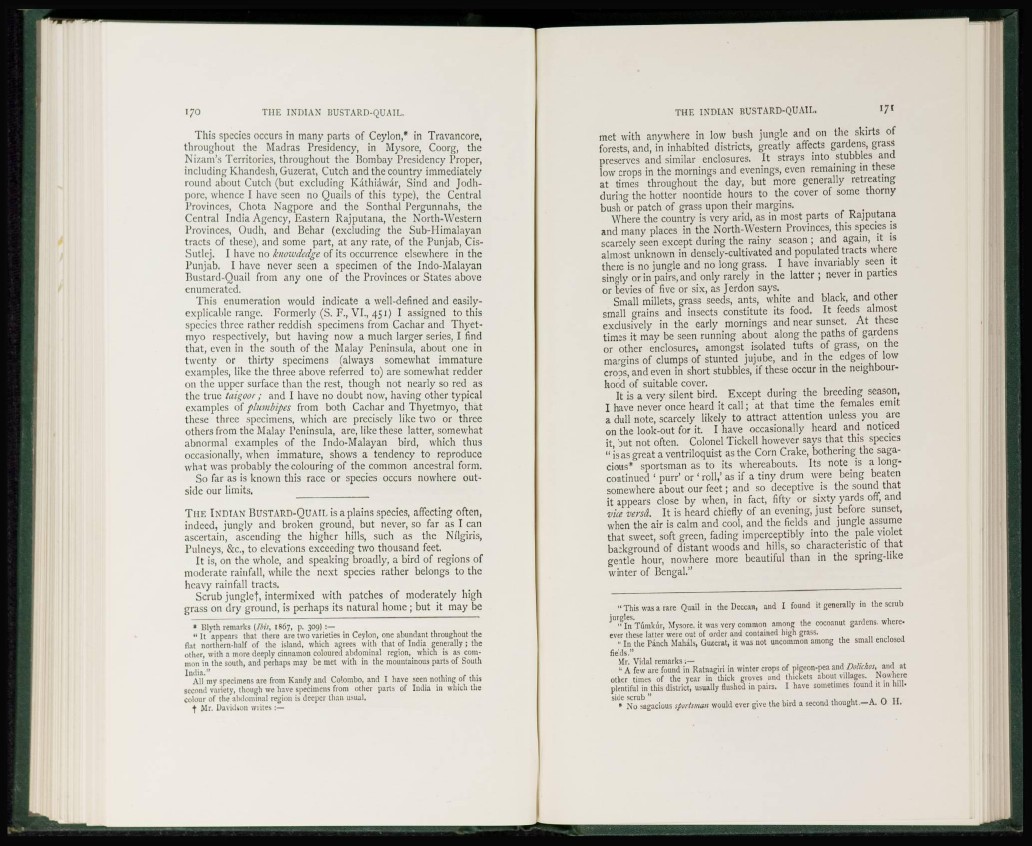
This species occurs in many parts of Ceylon,* in Travancore,
throughout the Madras Presidency, in Mysore, Coorg, the
Nizam's Territories, throughout the Bombay Presidency Proper,
including Khandesh, Guzerat, Cutch and the country immediately
round about Cutch (but excluding Kathiawar, Sind and Jodhpore,
whence I have seen no Quails of this type), the Central
Provinces, Chota Nagpore and the Sonthal Pergunnahs, the
Central India Agency, Eastern Rajputana, the North-Western
Provinces, Oudh, and Behar (excluding the Sub-Himalayan
tracts of these), and some part, at any rate, of the Punjab, Cis-
Sutlej. I have no knowdedge of its occurrence elsewhere in the
Punjab. I have never seen a specimen of the Indo-Malayan
Bustard-Quail from any one of the Provinces or States above
enumerated.
This enumeration would indicate a well-defined and easilyexplicable
range. Formerly (S. F., V I . , 4 5 1 ) I assigned to this
species three rather reddish specimens from Cachar and Thyetmyo
respectively, but having now a much larger series, I find
that, even in the south of the Malay Peninsula, about one in
twenty or thirty specimens (always somewhat immature
examples, like the three above referred to) are somewhat redder
on the upper surface than the rest, though not nearly so red as
the true taigoor ; and I have no doubt now, having other typical
examples of plumbipes from both Cachar and Thyctmyo, that
these three specimens, which are precisely like two or three
others from the Malay Peninsula, are, like these latter, somewhat
abnormal examples of the Indo-Malayan bird, which thus
occasionally, when immature, shows a tendency to reproduce
what was probably the colouring of the common ancestral form.
So far as is known this race or species occurs nowhere outside
our limits.
THE INDIAN BUSTARD-QUAIL is a plains species, affecting often,
indeed, jungly and broken ground, but never, so far as I can
ascertain, ascending the higher hills, such as the Ntlgiris,
Pulneys, &c, to elevations exceeding two thousand feet.
It is, on the whole, and speaking broadly, a bird of regions of
moderate rainfall, while the next species rather belongs to the
heavy rainfall tracts.
Scrub junglct, intermixed with patches of moderately high
grass on dry ground, is perhaps its natural home ; but it may be
» Blyth remarks (Ibis, 1867, p. 309) :—
" It appears that there are two varieties in Ceylon, one abundant throughout the
flat northern-half of the island, which agrees with that of India generally ; the
other, with a more deeply cinnamon coloured abdominal region, which is as common
in the south, and perhaps may be met with in the mountainous parts of South
All my specimens are from Kandy and Colombo, and I have seen nothing of this
second variety, though we have specimens from other parts of India in which the
colour of the abdominal region is deeper than usual.
f Mr. Davidson writes :—
met with anywhere in low bush jungle and on the skirts of
forests, and, in inhabited districts, greatly affects gardens, grass
preserves and similar enclosures. It strays into stubbles and
low crops in the mornings and evenings, even remaining in these
at times throughout the day, but more generally retreating
during the hotter noontide hours to the cover of some thorny
bush or patch of grass upon their margins.
Where the country is very arid, as in most parts of Rajputana
and many places in the North-Western Provinces, this species is
scarcely seen except during the rainy season ; and again, it is
almost unknown in densely-cultivated and populated tracts where
there is no jungle and no long grass. I have invariably seen it
singly or in pairs, and only rarely in the latter ; never in parties
or bevies of five or six, as Jerdon says.
Small millets, grass seeds, ants, white and black, and other
small grains and insects constitute its food. It feeds almost
exclusively in the early mornings and near sunset. At these
times it may be seen running about along the paths of gardens
or other enclosures, amongst isolated tufts of grass, on the
margins of clumps of stunted jujube, and in the edges of low
crops, and even in short stubbles, if these occur in the neighbourhood
of suitable cover.
It is a very silent bird. Except during the breeding season,
I have never once heard it call; at that time the females emit
a dull note, scarcely likely to attract attention unless you are
on the look-out for it. I have occasionally heard and noticed
it, but not often. Colonel Tickell however says that this species
" is as great a ventriloquist as the Corn Crake, bothering the sagacious*
sportsman as to its whereabouts. Its note is a longcontinued
' purr' or ' roll,' as if a tiny drum were being beaten
somewhere about our feet; and so deceptive is the sound that
it appears close by when, in fact, fifty or sixty yards off, and
vice versd. It is heard chiefly of an evening, just before sunset,
when the air is calm and cool, and the fields and jungle assume
that sweet, soft green, fading imperceptibly into the pale violet
background of distant woods and hills, so characteristic of that
gentle hour, nowhere more beautiful than in the spring-like
winter of Bengal."
" This was a rare Quail in the Deccan, and I found it generally in the scrub
'""on'Tdmkur, Mysore, it was very common among the cocoanut gardens, whercever
these latter were out of order and contained high grass.
•• In the Pinch Mahals, Guzerat, it was not uncommon among the small enclosed
fields."
Mr. Vidal remarks ,. , ,
" A few are found in Ratnagiri in winter crops of pigeon-pea and Vohcltos, aim at
other times of the year in thick groves and thickets about villages. Nowhere
plentiful in this district, usually flushed in pairs. I have sometimes found it in hill-
* No sagacious sportsman would ever give the bird a second thought—A. 0 H.